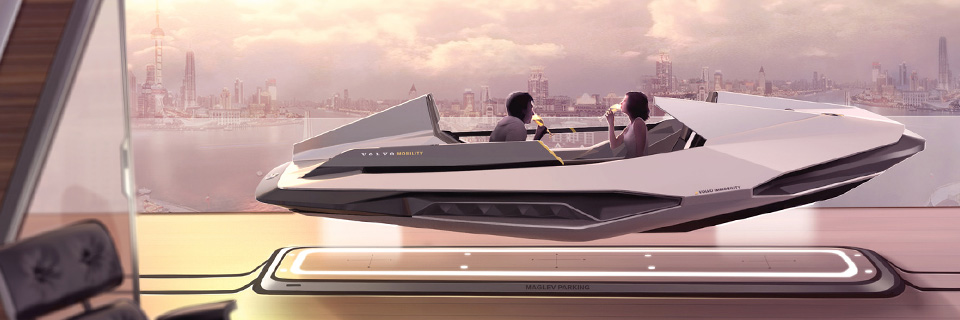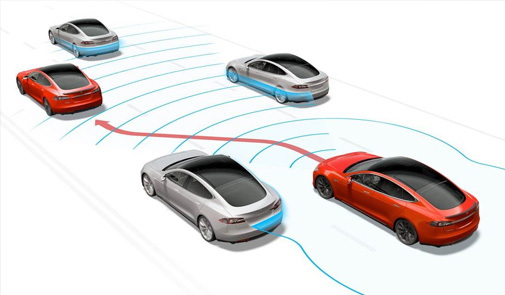Make Driving
Great Again
Ripe for innovation
 Illustration by YUHAN ZHANG
Illustration by YUHAN ZHANGKnow people's needs and make it accessabel
Recently my colleague remarked that despite the large touch screens manufacturers have added into cars, he can still only change the temperature. The in-car experience is far behind smartphone and tablet software experience. Most current car systems are poorly designed without the possibility of an update. Drivers are challenged by the lack of a cohesive concept between the Instrument Cluster and Head Unit, not to mention the overall weak user experience. The car industry has a huge opportunity to shape our experience, making our life easier and more enjoyable. Knowing what each person needs and making it accessible at the right time is where the car manufacturers can find their new business models. Manufacturers will look to subscription-based software platform like DirecTV or Netflix, as the new method for delivering in-car features.
It works just fine
I’m constantly amazed by the way my Model S handles the road in it’s autopilot driving mode. Currently I only have it on the free trial for 10 more days. Tesla offered a free 30 day trial to drivers like me and if I don’t pony up $3,000 by the end of the period, the company will revoke the service. But now I’m addicted, right? There is the beauty (and agony) of the subscription model.
 The most painful part of my job is my daily commute. For over an hour each way, I crawl along the 10 freeway in Los Angeles stopping and starting, never topping 8 mph. I totally get why skateboarding on the highway is the latest trend. (LA Times: Videos of skateboarders on freeways) With the autopilot feature, I can check my emails and participate in my morning meetings. (Not saying this is exactly legal, of course.) But I’m able to be productive while driving. This has made a huge difference in my life.
The most painful part of my job is my daily commute. For over an hour each way, I crawl along the 10 freeway in Los Angeles stopping and starting, never topping 8 mph. I totally get why skateboarding on the highway is the latest trend. (LA Times: Videos of skateboarders on freeways) With the autopilot feature, I can check my emails and participate in my morning meetings. (Not saying this is exactly legal, of course.) But I’m able to be productive while driving. This has made a huge difference in my life.
Not only has this feature changed my ability to work, it’s also changed my ability to relax. I love turning on autopilot on my long drives out to the desert. Now I can travel great distances with only occasionally touching the steering wheel. My weekend starts when I get in the car, as opposed to when I arrive at my destination. As Richard Kim discusses in his interview on archinect.com, relaxing while driving is no longer a concept or future fantasy, it has arrived.
More important than comfort, it also saves lives. (Tesla: Still a complete family) Last year on my slow morning commute, I witnessed the driver of a Toyota SUV suffer an epileptic attack and lose control of his car. He veered from the fast lane all the way over to the far right lane, unconscious the entire time. Myself and the other drivers reacted in time and cleared a path for the vehicle. But if someone had been texting or turning around to tend to a baby in a car seat for a split second— who knows what could have happened? With autonomous driving, not only would the surrounding cars have quickly adjusted to prevent an accident, the driver’s vehicle would have already alerted the emergency systems that something was not right.
Being co-pilot in your own car
It feels odd in the beginning when the car takes over. It’s almost like teaching my kid how to drive. If a motorcyclist splits lanes it doesn't give as much clearance as I usually do. If the lanes merge it has trouble understanding which car to follow. Because it's not connected to the navigation system, it doesn't recognize the next exit on the freeway. Also, it doesn't recognize stop signs or traffic lights. This will all come sooner than later in one of the next over-the-air software updates. But what about the in-car experience? How can I connect the car’s system to my HUE so lights at home turn on or off when I’m arriving or leaving? When will it be possible to connect my car with NEST to synchronize the room temperature at home with temperature in my car and the other way around? How can the car manage permissions in order to enter properties or even the hotel when I arrive? If I can continue listen to my music I just enjoyed at home, how can I continue watching the movie from last night? This all is already possible via my phone but necessarily easy to use in the car.
Screen real estate
More strategic thinking is necessary if car manufacturers want to be part of the IoT and be able to add their own business layers. Implementing these kind of features into a car system require an advanced platform for more connectivity capabilities as well as user centered product management.
Shared cars will make software even more increasingly important for the car of the future. Car manufacturers have a huge opportunity to build an infrastructure as well as connected vehicles themselves. But if Apple and Google are stealing drivers attention, car manufacturers will have a hard time establishing their own systems.
In transition
We are approaching an in-between phase where modern technology and the old world overlap. In this dynamic time car manufacturers have the best opportunity to adjust their features and to finalize their products. It will help the consumer to process and learn (cnet: Summon Fail) as well to give feedback, so the industry can adjust and unfold their future vision in order to execute a holistic approach and - make driving great again.
-Dré Nitze-Nelson | 安德烈 尼采-纳尔逊
Dir. UX/UI IconMobile 06/2016 Los Angeles